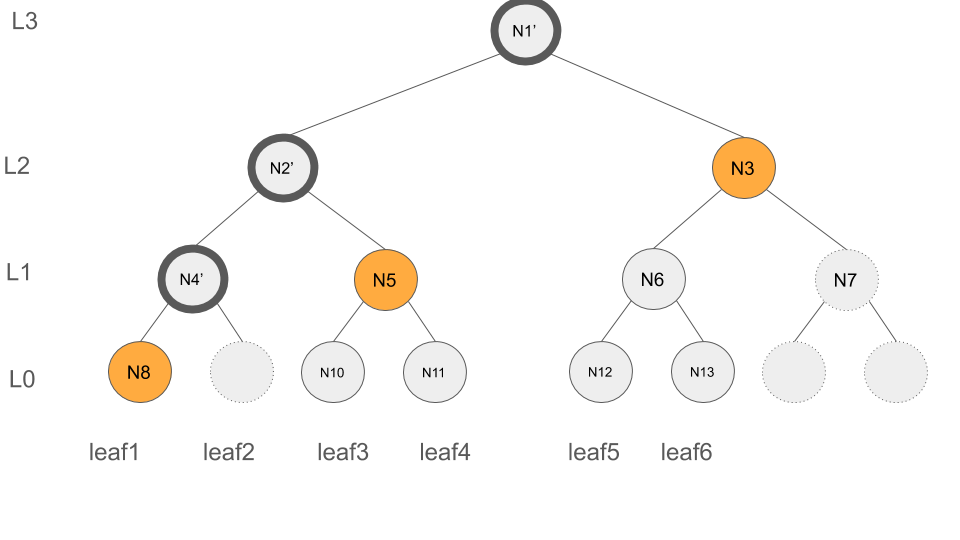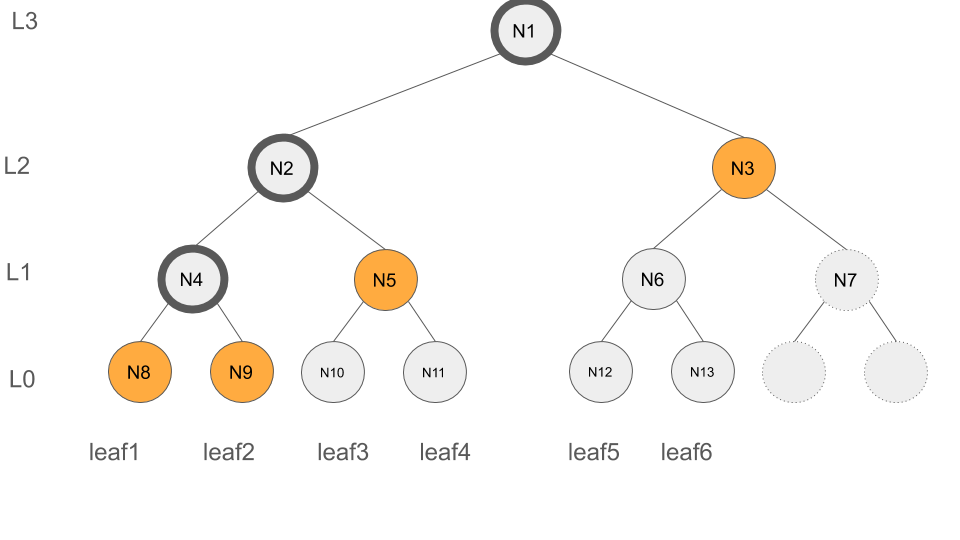3.3 KiB
Solution Overview
In a Merkle Tree with the capacity of n leaves , one can compute the root of the tree by maintaining the root nodes of log(n) number of complete Merkle trees.
We use this fact and define F to be an array of size log(n) holding the root of complete Merkle trees (all positioned on the left side of the tree) for levels [0, d=log(n)+1]. Each entry of F at position i holds a pair (index, H) where H is the root of the complete subtree at level i, and index indicates the index of the leaf node whose insertion resulted in H.
F = [(L0,H0,index0), ..., (Ld,Hd,indexd)]
For the Merkle Tree shown in Figure below, F = [(L0, N12, leaf5), (L1, N6, leaf6), (L2, N2, leaf4), (L3, N1, leaf6)] is highlighted in green. Note that none of the gray nodes are stored as part of F.

Deletion
Consider the deletion of the leafi with the authentication path / (membership proof) of the follwoing form authpath = [(L0,H0), ..., (Ld,Hd)].
The authentication path of leaf2 is illustrated in the following figure. authpath2 = [(L0, N8), (L1,N5), (L2,N3), (L3,N1)].
We need to update F based on authpath2. In specific, we need to determine whether any of the nodes whose values get altered as the result of deletion of a leaf node intersect with the nodes in F, and if this is the case the corresponding nodes in F shall get updated too.
Lets clarify it by the help of an example. Consider leaf2, the deletion of leaf2 impacts N9, N4, N2 and N1(root) of the tree.

Thus, in order to update F, we need to update those entries that contain N9, N4, N2 or N1.
- inputs:
authpath2 = [(L0, N8), (L1,N5), (L2,N3), (L3,N1)]F = [(L0, N12, leaf5), (L1, N6, leaf6), (L2, N2, leaf4), (L3, N1, leaf6)]
- Update procedure:
N9at levelL0, HasCommAnc(leaf2,leaf5) = no, thusFdoes not changeN4'at levelL1, HasCommAnc(leaf2,leaf5) = no, thusFdoes not changeN2'at levelL2, HasCommAnc(leaf2,leaf4) = yes, thusF = [(L0, N12, leaf5), (L1, N6, leaf6), (L2, N2', leaf4), (L3, N1, leaf6)]N1at levelL3, HasCommAnc(leaf2,leaf6) = yes, thusF = [(L0, N12, leaf5), (L1, N6, leaf6), (L2, N2', leaf4), (L3, N1', leaf6)]
- Output
F' = [(L0, N12, leaf5), (L1, N6, leaf6), (L2, N2', leaf4), (L3, N1', leaf6)]
Common Ancestor
In order to determine whether two nodes with indices i and j have common anscestor at a particular level lev, the followong formula can be applied
check whether floor( (i-1)/2^lev ) is equal to floor( (j-1)/2^lev )
Update algorithm
- Inputs:
F = [(H0,index0), ..., (Hd,indexd)]leafIndex( The index of the deleted leaf)authpath = [H0, ..., Hd](The authentication path of the deleted leaf)Z = [H(0), H(Z[0]||Z[0]), H(Z[1]||Z[1]), ..., H(Z[d-1]||Z[d-1])]
- Output:
F'
path = binary representation of leafIndex - 1
acc = Z[0]
for lev in 0..d # d inclusive
if HasCommAnc(leafIndex, F[lev].index,lev) == true # F[lev].index has common ancestor with leafIndex at level lev
F[l] = acc
if the last bit of path is 1
acc = H(authPath[lev], acc)
else
acc = H(acc, authPath[lev])
shift path right by 1
HasCommAnc(i, j, lev) =
return floor( (i-1)/2^lev ) == floor( (j-1)/2^lev )

